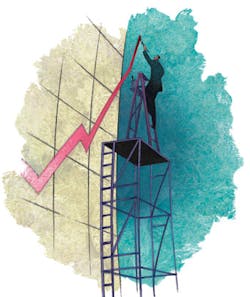Recession's Severity Evident, but Hopeful Signs Emerging
March 1, 2009
3 min read
From November 2007 to November 2008, the Fed reported that U.S. manufacturing capacity utilization declined from 79.3 percent to 72.3 percent. During that same span, the seasonally adjusted U.S. industrial production index fell from a value of 112.3 to a value of 106.1.While each manufacturer faces company-specific challenges, recognizing such broader characteristics of the current recession provides insight for making the most appropriate decisions regarding financial and operational concerns.This recession officially began in December 2007, but the events leading up to it differed from those that triggered past recessions. Recessions usually begin when manufacturers face slowing demand for their products. Inventories rise and profits fall. Those difficulties prompt downturns in other sectors of the economy, including the financial markets. For the current recession, though, instability that arose within the financial markets during the summer months of 2007 fostered economic turmoil elsewhere.The current recession also differs in length and severity from most past recessions. Since the Great Depression, recessions have typically lasted around 12 months, with the longest recession lasting 17 months, from July 1981 to January 1983. The present recession has passed that average duration, and its length may surpass the 17-month span of that early 1980s recession, too.The present recession’s unemployment impact may set a new benchmark as well. Various findings place current recession-related job losses at between 2.4 million and 2.6 million jobs. That equates to 1.7 percent of the workforce. In the early 1980s recession, 3 percent of the workforce suffered job losses.Businesses generally do not cut workforces until a recession is well underway. Conversely, when an economic upturn begins, companies are also reluctant to resume hiring employees. Workforce expansion serves as a lagging indicator of recovery. Considerably more job losses could occur this year. If the net job loss total exceeds 4 million jobs, this recession will exceed the early 1980s recession in the percentage of the workforce facing unemployment.Watch stock marketIncreases in unemployment spur declines in discretionary consumer spending, and companies that manufacture photographic equipment or other items regarded as discretionary consumer products face particularly daunting circumstances. While employment and discretionary spending declines follow a recession’s onset, upward movements within the stock market serve as early indicators of anticipated economic recovery.Such indicators were present on Jan. 9. The U.S. Department of Labor’s Bureau of Labor Statistics released its unemployment report that day for December 2008. The report showed that unemployment had risen from 6.8 percent to 7.2 percent in December, with 524,000 jobs lost that month. In response, however, the Standard and Poor’s 500 Index rose almost 5 percent, and the Dow Jones Industrial Average rose by 345 points. Those market gains indicated that investors were looking beyond the day’s dismal news to more promising times ahead.Other stock market trends provide encouragement as well. While stock prices for automakers, defense contractors, aerospace companies and other high-end manufacturers suffer, investor money is flowing into stocks for chemical producers, raw materials providers, fabricators and other companies involved in early-phase manufacturing.Regardless of what legislation is passed at the federal, state or local levels, falling energy prices and lower interest rates are providing economic stimulation. While such stimulants are welcomed, widespread economic growth may not be evident until the latter part of this year, or until early 2010. In the meantime, being aware of present conditions and the potential for recovery gives manufacturers greater perspective for making pressing critical decisions.Michael Benedict, CFP, [email protected], is a Senior Financial Advisor for Weaver and Tidwell Financial Advisors, Ltd.
About the Author
Sign up for our eNewsletters
Get the latest news and updates

Leaders relevant to this article:
